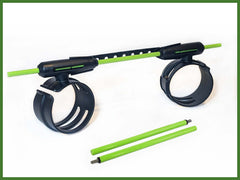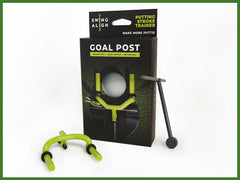The Difference Between a Chip and Pitch
The vast majority of golfers struggle with their short game. Whether you’re in the rough or the short grass around a green, it’s difficult to get a feel for short game shots that get the ball close to the hole. This article will teach you how to hit chip shots and pitch shots, the difference in chipping vs pitching, and why it is important to know which shot to play.
Let’s start with the basics. A chip is a low shot that is played along the ground and spends little time in the air. Chip shots are generally hit close to the green where the golfer does not need to carry the ball very far in the air and just wants to get the ball started and let it roll out towards the hole like a putt. Chip shots can be hit with a variety of different clubs from wedges down to as low as a #7 iron.
Conversely, a pitch shot is one that is played more through the air and does not have as much roll. Pitch shots carry farther than chip shots and can be played from longer distances up to around 30 yards. This shot travels higher and further in the air than a chip shot. Pitch shots are generally hit with your higher lofted clubs like a 54, 56, 58 or 60 degree loft utility wedge.
This article will explain the difference between chipping and pitching including the following.
- Set Up for Chip and Pitch
- Hitting a Chip
- Hitting a Pitch
- When to Pitch vs. Chip
- Practice Chips and Pitches with Swing Align!
How to Set Up for Chip and Pitch Shots
While chip and pitch shots are different there are many common elements to these shot game shots particularly in the set up. To set up properly for a short game shot keep your stance narrow. Your feet should be spaced no more than a foot apart. Your trail foot should be close to square to your target line while the lead foot can be rotated open. For your stance and alignment you want to be anywhere from square to the target to slightly open, but never closed. Accordingly the line of your shoulders should be square to the target to slightly open.
Two additional important elements to consider; your weight should always be more on your lead foot and your shoulders should be level. You do not want to tilt your spine back like you do for a full shot. Using an alignment device like Swing Align can be very helpful to building the proper set-up.
How to Hit a Chip Shot
The chip shot is essential to everyone’s golf game. Whether you’re an elite player who hits 15 greens over the course of a round or a beginner who hits two a day, there will always come a time when you are just off the green and need to chip the ball close to the hole in an effort to save par.
How to hit a proper chip shot:
- Choose the right club - A mistake that many amateurs make around the green is immediately grabbing their lob or sand wedge. While these clubs have their place, it takes a lot of time to master them. When you find yourself needing to chip the ball, grab your pitching wedges or even your 9-iron or 8-iron. These will ensure you get the ball rolling toward the hole and limit the number of mistakes around the green.
- Get in the right stance - Unlike a full swing or even a pitch shot, you want to stand closer to the ball on a chip shot. You’ll also want to place about 70% of your weight on your lead foot (left foot for right-handers and right foot for left-handers). This makes it easier to strike the ball first instead of the ground behind the ball.
- Put the ball back of center - You do not need to carry the ball very far with a chip so the ball should be slightly back of the center of your sternum. With this ball position your hands will be ahead of the ball and the shaft will have a slight amount of forward lean.
- Choking down is OK - Since a chip shot is a controlled shot like a putt, it is ok to grip down. While you want the full length of the club for full swings and some pitch shots to hit the ball farther, you want to have more stroke control when you’re chipping. Choking down helps achieve the control you need.
- Choose your landing point - An important part of chipping is visualizing where you want the ball to land. A good rule of thumb is to land the ball about 20% of the way to the hole on a chip shot. Assuming you hit it with the right loft club and proper amount of power, the ball will roll the rest of the way to the hole.
- Use your shoulders - The chip shot is similar to a putt but you’re using a lofted club instead of a flatstick. Keep your hands slightly ahead of the ball, make a smooth motion, and avoid decelerating as you approach the ball. You don’t need any lower body rotation or movement to hit a pitch shot, but your lower body can follow your upper body on the downswing and turn slightly towards the hole at your finish.
How to Hit a Pitch Shot
While the pitch shot requires a similar technique as a chip shot, it requires a slightly different approach. Pitch shots are essential to learn because you will not always be right next to the green. In many cases you will need to hit the ball higher and carry it over some rough or a bunker. Pitch shots fly farther than chips and stop quicker giving you the ability to save par from difficult circumstances.
How to hit a proper pitch shot:
- Choose the right club - A pitch shot requires a club with more loft than a chip. You’ll want to use anything between a gap wedge and lob wedge. These clubs will get more air underneath the ball and allow a softer landing.
- Get in the right stance - The stance for a pitch shot falls in between a chip shot and a full shot. You can be a little closer to the ball than you would a full shot, but not as close a chip. In terms of weight you want slightly more on your lead foot. The ball position should be in the center and you should have almost no shaft lean.
- Pick your landing spot - Depending on the club you use the landing spot for a pitch shot should be about 50% of the way to the hole or more. The loft of the club will allow the ball to land soft and roll out, but not as much as a chip shot.
- Open the face and accelerate through - Everyone has stubbed a pitch shot before. This is usually caused by the leading edge of the wedge sticking in the ground or decelerating your stroke as you come into the ball. Solution? Open the face of your wedge slightly. This will let you use the bottom surface or bounce on the wedge to keep it from sticking in the ground. Be confident in your motion and keep the acceleration through the strike.
- While a chip shot is closer to a putt, a pitch shot is closer to your full swing. As you take the club back you can incorporate a little trail arm fold and rotation and some wrist hinge. You do not however want to get too handsy so you still want to control the shot mostly with your body rotation. Much like a chip you do not need lower body rotation on the way back but your lower body should rotate towards your target on the downswing and follow through.
When to Pitch vs. Chip
While it is important to know how to hit both chip and pitch shots, it’s even more important to know when to chip vs pitch. There are two basic factors that go into the golf chipping vs pitching decision:
- Lie - If you have a clean look at the back of the ball (i.e. you are on the fairway or have a good lie in the rough) a chip shot is likely the way to go. When you can make a clean strike and get the ball rolling towards the hole like a putt it gives you more control. If the lie is poor, choose a pitch shot to get the ball up and out so it can land soft.
- Shot requirement - This is the most important factor. If you are close to the green without the need to carry the ball over any trouble you should almost always choose a chip shot. If however you do need to carry the ball, or to get it to stop more quickly near a difficult pin placement, a pitch shot is better.
- Skill level - In general, the pitch shot is more difficult than a chip shot as there is more room for error. We suggest mastering the chip shot first and then move on to the pitch.
Feel the Difference Between Chipping and Pitching with Swing Align!
The correct short game form is vital to gaining confidence around the greens. Knowing the difference between chipping and pitching is vital. Use the Swing Align trainer and Short Game Rod to help teach you proper chipping and pitching set-up and mechanics! Swing Align will help you align your upper body relative to your lower body and the target. It immediately shows your shoulder alignment and spine tilt. Swing Align will teach you how much rotation is needed to hit chip and pitch shots. The Swing Align Short Game Rod will help you stay connected and use your larger muscles to control your short game swing providing the essential shot and distance control you need around the greens.

The Swing Align Short Game product gives you instant feedback helping you to make the most out of your practice sessions.
Improve Your Short Game with Swing Align!
It takes practice, but golf gets a lot easier once you are confident around the greens. Nothing feels better than saving par and avoiding mistakes around the green to help lower your score. This means knowing how and when to chip or pitch the ball. Practice our tips with the Swing Align Short Game configuration and watch your scores drop with ease. Visit Swing Align’s full catalog of products for help with all areas of your game!
















